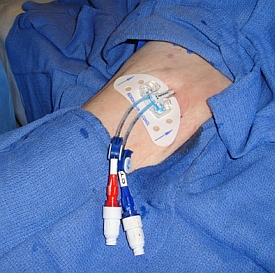Medical researchers at University of Michigan in Ann Arbor found a widely used catheter for intravenous (IV) drug delivery is linked to a higher risk of deep vein blood clots, particularly among critically ill patients or those with cancer. The findings of the team led by internal medicine professor Vineet Chopra, which show associations and not necessarily cause-and-effect, appear today online in the journal The Lancet (paid subscription required).
Chopra’s team, including colleagues from the Ann Arbor Veterans Affairs Medical Center, investigated peripherally inserted central catheters, or PICCs, that are placed in the arm to deliver intravenous drugs, fluids, and nutrition. PICCs are considered more suitable for longer term use and safer to insert than central venous catheters that are placed in large veins in the neck, groin, or chest.
The researchers looked specifically at the risks associated with PICCs of deep vein thrombosis, a type of blood clot that occurs in and causes damage to larger veins in the lower leg or thigh. These clots pose additional risks for patients, when they break off and move through the blood stream, becoming an embolism that can get stuck in the brain, heart, or lungs, causing further life-threatening damage. The Centers for Disease Control and Prevention last year reported nearly 349,000 cases per year of deep vein thrombosis in the U.S. from 2007 through 2009, particularly among those age 60 and older.
Chopra and colleagues analyzed past research on the incidence of deep vein thrombosis among adult patients using PICCs, and in some cases where the findings were compared to reports of deep vein thrombosis with central venous catheters. The team scoured databases of published studies, both Internet-based and hard-copy, as well as direct inquiries to authors of unpublished data. The searches yielded 64 studies, of which 12 inquiries compared the two techniques, involving some 29,500 patients.
In the comparison studies, the researchers found deep vein thrombosis occurring in 2.7 percent of the cases where PICCs were inserted, a risk some 2.6 times higher than when central venous catheters were used. The studies looking only at deep vein thrombosis in patients with PICCs showed considerably higher rates among patients in critical care units (14%) and cancer patients (7%), both of which already face higher clotting risks.
Chopra says PICCs will continue to be the best choice of IV delivery for some people, but physicians should consider benefits and risks before choosing this technique. “Our study shows that this risk may be higher than previously recognized,” notes Chopra, “and suggests that there is no one-size-fits-all approach when considering use of these devices.”
Read more:
- No Disability Improvement Seen from Clot Device After Stroke
- Checklist System Helps Cut Hospital Blood Clot Cases
- NIH Grant to Fund Translational Research on Blood Clotting
- Biotech Begins Clinical Trial for Stroke Treatment
- Synthetic Platelets Developed for Therapies, Diagnostics
* * *


 RSS - Posts
RSS - Posts
You must be logged in to post a comment.